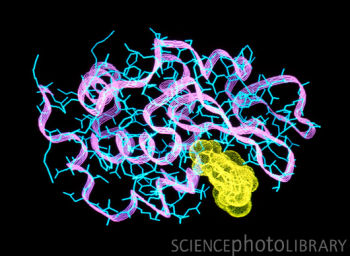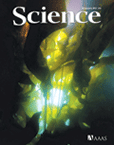
自诺贝尔获奖者 Alexander Fleming在20世纪发现人类的眼泪里有杀菌作用的蛋白溶菌酶后,科学家一直尝试解开这个谜题——溶菌酶是如何能够无情的杀死大量的细菌。最新研究发现溶菌酶可以吞噬细菌并分离细菌的细胞壁就像饥饿的人吞玉米一样。这项研究发表在1月20日发表的Science杂志上。
分子生物学家和化学教授Gregory Weiss说,溶菌酶可以分离试图进入眼睛中并进行感染的细菌的细胞壁。Gregory Weiss和物理学和天文学副教授Philip Collins共同主导了这项研究。
研究人员设计出世界最小的晶体管解码蛋白质的行为——这种晶体管的电路更小巧,是笔记本电脑和智能手机中相同电路的1/25。通电的线路紧贴着每个溶菌酶,监控溶菌酶吞噬细菌的行为。
我们的电路是分子般大小的麦克风,Collins说,它就像是心脏的听诊器,只不过它听的是单个蛋白质分子。
UCI研究人员花费数年时间安装这个晶体管并把它连接到单个蛋白质分子上。科研人员希望这项新奇的技术能够应用到探测癌分子上。Weiss说实现这个目标可能需要花费数十年的时间,但这是值得的,Weiss的父亲死于肺癌。
如果我们能探测到跟癌症有关的单个分子,这就意味着我们能够在早期就能探测到癌症。Weiss说,那会让人很兴奋,因为如果癌症能早点治疗,治愈的成功率更大,病人能更快的被治愈,成本也就更低。

Single-Molecule Lysozyme Dynamics Monitored by an Electronic Circuit
Yongki Choi, Issa S. Moody, Patrick C. Sims, Steven R. Hunt, Brad L. Corso, Israel Perez, Gregory A. Weiss, Philip G. Collins
Tethering a single lysozyme molecule to a carbon nanotube field-effect transistor produced a stable, high-bandwidth transducer for protein motion. Electronic monitoring during 10-minute periods extended well beyond the limitations of fluorescence techniques to uncover dynamic disorder within a single molecule and establish lysozyme as a processive enzyme. On average, 100 chemical bonds are processively hydrolyzed, at 15-hertz rates, before lysozyme returns to its nonproductive, 330-hertz hinge motion. Statistical analysis differentiated single-step hinge closure from enzyme opening, which requires two steps. Seven independent time scales governing lysozyme’s activity were observed. The pH dependence of lysozyme activity arises not from changes to its processive kinetics but rather from increasing time spent in either nonproductive rapid motions or an inactive, closed conformation.
文献链接:https://www.sciencemag.org/content/335/6066/319.abstract?sid=878f4e8e-353a-4138-b195-3c1a12f9a35b








